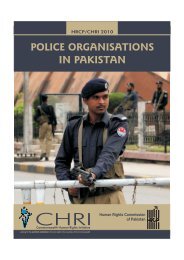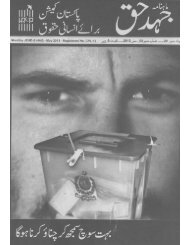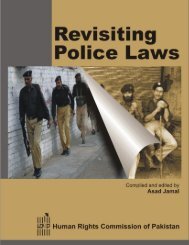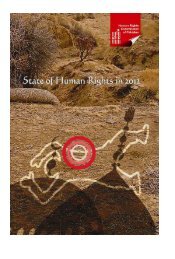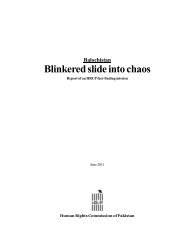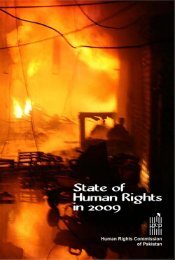Download PDF file - HRCP
Download PDF file - HRCP
Download PDF file - HRCP
You also want an ePaper? Increase the reach of your titles
YUMPU automatically turns print PDFs into web optimized ePapers that Google loves.
<strong>HRCP</strong> fact-finding missions’ report 61<br />
including seven in death cells, and 55 under-trials. A part of the jail had been earmarked for women but it had neither<br />
a prisoner nor a warden. There had been occasions when a single female prisoner was housed in the jail, guarded by<br />
men. There was one juvenile convict (drug charge). There was no problem of transporting the under-trials to courts.<br />
The condemned prisoners were under 24-hour restraints. Medical facilities were poor. Several prisoners contested<br />
the officials’ statement that each prisoner was medically examined at the time of admission. There was no woman<br />
doctor at the jail. In case a female detainee needed medical attention, she would be sent to the DHQ Hospital. The jail<br />
staff said they had no special instructions regarding juvenile detainees.<br />
At Khuzdar, it was said that the Giddani jail was notorious for violence against women detainees. At the time of<br />
<strong>HRCP</strong> visit the murder of a woman in this jail was being hotly discussed in public. Investigations were in progress.<br />
There were no women’s or children’s wards at the district jail.<br />
The jail in Loralai had more detainees (95) than its capacity (75). The convicts numbered 49 and the rest (46)<br />
were under trial. The detainees included seven juveniles and one woman (facing trial under an Hudood Ordinance).<br />
The juveniles were not receiving the benefits of the Juvenile Justice System Ordinance.The jail had no doctor. Once<br />
a week the jail was visited by a doctor from the district hospital. Some of the under-trials complained of delays in<br />
appeal stages. The convicts said they did not have facilities for pursuing studies.<br />
At the Mach Central Jail the <strong>HRCP</strong> team found 991 prisoners as against the capacity for 600 prisoners. All of the<br />
prisoners were convicts – 135 on the death row, 28 foreigners, and 818 serving different periods of sentence. Most<br />
of the under-18 convicts had been tried on drug-related charges.<br />
Numerous complaints of illegal detention by the police, illegal confinement before securing remand, and torture<br />
in custody were heard in Turbat and Tump.<br />
Complaints against the coastguards were a legion. Everywhere they were accused of harassing travellers at<br />
pickets set up ostensibly to check drug trafficking and smuggling in other goods. These complaints related to<br />
coastguards’ high-handedness, lack of respect for human dignity, and extortion (especially from those engaged in<br />
smuggling daily utility items/consumer goods to and from Iran). Access to senior officials was difficult.<br />
The people generally complained of a rise in crime. They also complained of lack of protection against criminal<br />
elements and the oppression of the tribal elite. The police officials disagreed. For instance, the Turbat DPO claimed<br />
the people’s sense of security would increase following the recent police success in busting criminal gangs. He<br />
admitted the tribal elite wielded considerable influence but its members were called to account if they indulged in<br />
high-handedness. According to him the police in Balochistan was ‘miskeen’ and not like the Punjab police. The people<br />
were docile and the police was not aggressive. There had been no death in custody.<br />
Criminal gangs<br />
A most serious instance of gang-power was noticed at Khuzdar. A group of criminal elements had taken over the<br />
circuit house where it held court, issued summons in writing, extorted protection money, and tried to settle disputes<br />
through terror tactics. The police, district administration and intelligence agencies were believed to be protecting the<br />
group. At least they did little to end its criminal activities, though several complaints had reportedly been made by the<br />
victims. It was also alleged that if any member of the gang was arrested he was forcibly taken out of the police<br />
station. The group was said to enjoy the backing of sardars and the tribal elite.<br />
In Loralai, the presence of a large body of Afghan refugees (said to be about 20% of the city’s population) many<br />
of them having acquired Pakistan papers, was said to pose economic and law-and-order problems. It was generally<br />
believed that crime and use of illegal weapons had increased after their arrival. The predominantly Pashtun population<br />
of Loralai bordered with Baloch-majority districts. The threat of clashes between Lunis (Pakhtuns) and Marris<br />
(Baloch) over mining operations was recognised by all, but the authorities had done nothing to resolve their disputes.<br />
Activities of intelligence agencies<br />
Complaints of intelligences agencies’ (ISI in particular and also MI) interference in governance and administration<br />
were vigorously voiced in Khuzdar. It was alleged that the intelligence agencies were protecting criminal elements<br />
involved in kidnapping for ransom and drug trafficking. Another allegation was that the intelligence agencies supported<br />
religious parties and promoted their interests.<br />
Two cases in Khuzdar were cited as examples of intelligence agencies’ influence over police and their interference<br />
with the justice system. One involved the arrest and detention on vague charges of journalist-activist Rashid Azam,



